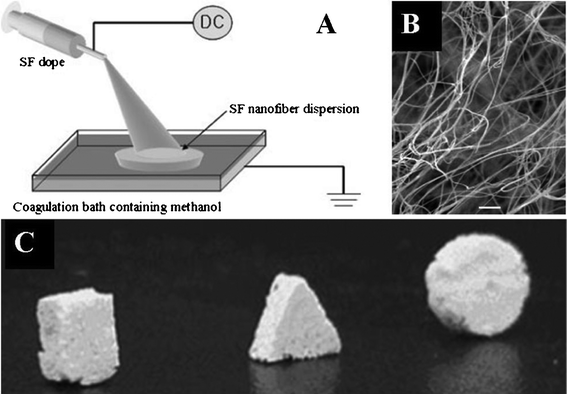

The silk protein scaffold is considered to be a natural biocompatible material, and the ECM derived from CFs can effectively mimic the myocardial microenvironment. In this study, we aimed to construct a CFs-derived ECM-coated SF scaffold and further inoculate BASCs to explore its differentiation and related mechanisms. Thus, ECM may have applications in the modification of SF scaffold for material modification and myocardial remodeling. The ECM acts as a cellular support and directs cell fate through coordinated physical and biochemical cues. Decellularized ECM is a biomaterial that best mimics the native cellular microenvironment, showing good bioactivity, biodegradability and biocompatibility. However, the functionality of SF scaffold still needs to be further improved. SF scaffold is a kind of traditional scaffold materials that show good bioactivity and biocompatibility, which may facilitate the construction of tissues, such as tendons, cortex and bones.

However, no studies have described the use of a CF-derived matrix for modification of tissue engineering scaffolds. One report used a CF-derived matrix to promote the maturation of neonatal rat CMs. Therefore, CF-derived matrix materials have attracted much attention because of the presence of micro environmental factors that promote cell growth. ECM secreted by CFs is also an important component of the cardiac matrix and is closely related to cardiac development, structure, cellular signaling systems and electromechanical function. CFs account for ∼60–70% of the total number of normal myocardial tissue cells, which are widely present in the heart and surround CMs. Cardiac fibroblasts (CFs) are important stromal cells that secrete ECM components, such as collagen, in the heart. used Schwann cell-derived ECM-modified chitosan/silk fibroin (SF) for bridging rat sciatic nerve gaps. Accordingly, the choice and functionalization of the material are important considerations when constructing ECTs.įunctionally scaffolds modified with cell-derived extracellular matrix (ECM) have been developed some studies also used ECM derived from terminally differentiated cells, stem cells to explore the developmental rules of stem cell osteogenesis, adipogenesis and differentiation into nerve cells. Studies have shown that the components, stereo structure, hardness and microenvironment-regulating ability of the scaffold material can affect cardiomyocyte (CM) remodeling and the quality of the reconstructed ECTs. These materials can promote disk formation and enhance the electrical integration between ECTs and the host myocardium. In recent years, more and more researchers have begun to pay attention to modified scaffold for example, carbon nanotube material composite gelatin has conductive properties, and fullerenol nanoparticle-modified chitosan scaffolds have antioxidant and conductive properties.

Scaffold as a part of myocardial tissue engineering play important roles in myocardial remodeling. Overall, these findings provide insights into the bionic manufacturing of engineered cardiac tissues (ECTs) and establish a theoretical basis for the construction of ECTs.Ĭell-derived extracellular matrix, cardiac fibroblasts, brown adipose stem cells, silk fibroin scaffolds IntroductionĬardial tissue engineering has developed rapidly in recent years, and engineered cardiac tissues (ECTs) have been constructed in vitro based on different scaffold guided by various construction strategies. Notably, the β1-integrin-dependent transforming growth factor-β1 signaling pathway was also involved in the regulation of CF-derived ECM by promoting the differentiation of BASCs into CMs. cardiac troponin T and α-actinin) of BASCs. We found that the CF-derived ECM-coated scaffold also increased the expression of CM-specific proteins (e.g. Further to explore its effects on brown adipose stem cells (BASCs) differentiation into CMs. The results showed that the cell-derived ECM-modified silk fibroin scaffold material contained collagen, laminin, fibronectin and other ECM components with myocardial-like properties. CFs were seeded on the SF scaffold for 10 days culturing and decellularized to produce CFs-derived ECM-coated SF scaffold. Here, a new hybrid scaffold is designed based on silk fibroin (SF) scaffold and CFs-derived ECM. ECM derived from cardiac fibroblasts (CFs) are considered as key elements that provide a natural cell growth microenvironment and change the fate of cardiomyocytes (CMs). The cell-derived extracellular matrix (ECM)-modified scaffolds have advantages of mimic tissue specificity and been thought to better mimic the native cellular microenvironment in vitro.


 0 kommentar(er)
0 kommentar(er)
